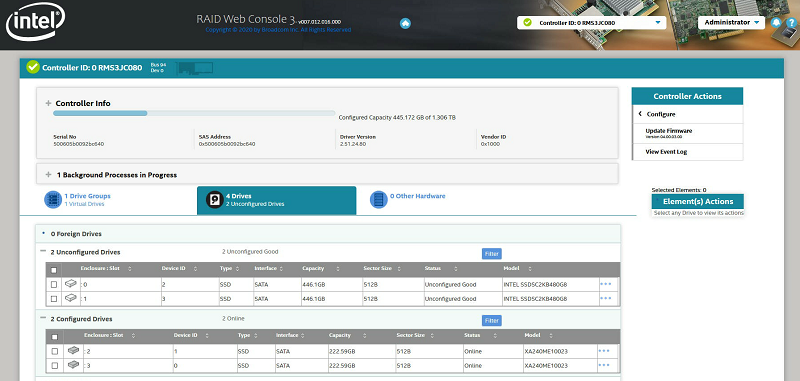

- INTEL RAID MONITOR SOFTWARE INSTALL
- INTEL RAID MONITOR SOFTWARE DRIVERS
- INTEL RAID MONITOR SOFTWARE DRIVER
- INTEL RAID MONITOR SOFTWARE SOFTWARE
# mdadm -C /dev/md/imsm -raid-devices=2 -metadata=imsm /dev/sd Continue creating array? y mdadm: container /dev/md/imsm prepared.Ĥ. Create a container named /dev/md/imsm on the target devices using the imsm ( Intel Matrix Storage Manager) metadata format. Because Intel RST utilizes external metadata, we must first create a container for our array. # lsblk NAME MAJ:MIN RM SIZE RO TYPE MOUNTPOINT sda 8:0 0 100G 0 disk sdb 8:16 0 100G 0 diskģ. Note: The RAID can alternatively be created via the Intel RST option ROM- the results are identical. You may need to adjust the parameters accordingly to suit the configuration of your system. The following example utilizes mdadm to create a 2-device RAID-1 array named /dev/md/data comprised of /dev/sda and /dev/sdb.
INTEL RAID MONITOR SOFTWARE INSTALL
Our primary goals are to create the RAID array, install the operating system, and configure the operating system to assemble the array during boot. If you have anything important on any disk connected to the system, ensure you have a backup! WARNING: These commands can destroy data if used incorrectly. Hooks can be utilized to include udev rules in the initramfs that handle the automatic assembly of RAID arrays at boot time. udev handles hardware events (such as addition/removal) with actions defined in rules. Udev is the device manager for the Linux kernel. Binaries are simply binaries (with all of their dependencies) to be included in the environment, and hooks are scripts that are executed in a provided order.

Mkinitcpio uses the concepts of binaries and hooks when preparing the initramfs. The initramfs is compiled via the mkinitcpio command.
INTEL RAID MONITOR SOFTWARE DRIVERS
The initramfs contains any drivers and scripts necessary to make the real root filesystem accessible.

Therefore, an existing array must be assembled - that is, identified and mounted - at boot time for md to manage it.Īssembly happens within the initial ramdisk, which is the initial Linux environment mounted by the booting kernel. The Boot ProcessĪs mentioned earlier, firmware-based RAID solutions are ultimately managed by the operating system. It is now deprecated mdadm should be used instead.
INTEL RAID MONITOR SOFTWARE SOFTWARE
This refers to the utility formerly used for managing firmware and software RAID. Note: A significant amount of older documentation references dmraid. For arrays with external metadata, md uses the concept of a container to manage a set of devices, and arrays are created within containers.įor more information, refer to the md and mdadm man pages. For firmware-based RAID solutions such as Intel RST, md is also capable of supporting external metadata - metadata managed outside the context of the driver. For purely software-based RAID solutions, md can directly manage the metadata. Metadata is information that describes the structure and state of an array. Within a RAID, devices may have metadata (also known as a superblock). These virtual devices are stored at /dev/md * (or /dev/md/ * in the case of named arrays).
INTEL RAID MONITOR SOFTWARE DRIVER
The md driver provides virtual devices that represent disks and partitions on the array. In Linux, the mdadm ( multiple device administrator) utility is considered the industry standard for managing firmware and software RAID. As such, Intel RST is not an ideal option for users with critical reliability requirements - but it is a very reasonable choice for home users looking to achieve additional redundancy or performance. Additionally, firmware and software RAID do not benefit from features such as battery-backed write caching that are often included on dedicated controllers. The burden of processing is delegated to the host CPU. This firmware-based RAID (also known as “ fake RAID”) is an attractive option because it permits functionality such as disk mirroring without further monetary investment.įirmware and software RAID differ from hardware RAID in that the array is ultimately managed by the operating system instead of a dedicated controller. Intel Rapid Storage Technology, previously known as Intel Matrix RAID, is a feature included on several modern Intel chipsets. It is useful to have an understanding of several concepts before proceeding: Intel Rapid Storage Technology While basic RAID concepts are beyond the scope of this guide, I will describe appropriate use cases of Intel RST versus other solutions and describe the process of configuring a RAID-1 array. This post aims to serve as a guide for users installing Arch Linux with RAID-1 using Intel Rapid Storage Technology (RST). Additionally, it can be extremely unnerving to configure storage when one isn’t entirely sure if what they’re doing is correct. Information is often conflicting or even entirely out-of-date. This is somewhat due to the fact that the amount of information on the topic is absolutely overwhelming. RAID is a common choke point for users installing Linux.


 0 kommentar(er)
0 kommentar(er)
